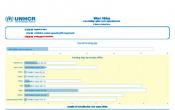Nigeria
Operation: Nigeria
Location
{"longitude":9,"latitude":9,"zoom_level":0}
Latest update of camps and office locations 13 Jan 2016. By clicking on the icons on the map, additional information is displayed.
Key Figures
| 2015 end-year results | |
| 128,708 | individuals with severe protection needs were identified through protection monitoring in north-east Nigeria |
| 450 | women/girls in need of counseling were provided with psychosocial support |
| 4,470 | solar lanterns were provided to women and girls |
| 11,408 | vulnerable displaced persons were reached with emergency and permanent shelter materials, including 1,451 emergency tents and 200 permanent shelters |
| 350 | vulnerable IDP women were provided with livelihood support In the form of skills training |
| 452 | Cameroonian refugees were assisted to voluntarily repatriate in 2015 |
Budgets and Expenditure for Nigeria
< Back
2015
{"categories":[2012,2013,2014,2015,2016],"budget":[null,null,null,null,40.90696755],"expenditure":[null,null,null,null,null]}
{"categories":[2012,2013,2014,2015,2016],"p1":[null,null,null,null,1.82155943],"p2":[null,null,null,null,null],"p3":[null,null,null,null,2.831583],"p4":[null,null,null,null,36.25382512]}
{"categories":[2012,2013,2014,2015,2016],"p1":[null,null,null,null,null],"p2":[null,null,null,null,null],"p3":[null,null,null,null,null],"p4":[null,null,null,null,null]}
Loading ...
CHOOSE A YEAR
- 2015
- 2016
Working environment
- The operational environment was marked by the 2015 Nigerian presidential elections which led to a peaceful transfer of power.
- The conflict and escalation of insurgencies and counter-insurgencies in the north-east resulted in a protection crisis, triggering the internal displacement of over 2 million Nigerians and the flight of nearly 146,000 to Cameroon, Chad and Niger.
- The response to internal displacement in Nigeria was led by the Government in close coordination with humanitarian actors, namely the National Emergency Management Agency (NEMA) and the State Emergency Management Agency (SEMA).
- UNHCR advocated the establishment of legal and policy frameworks for the protection of internally displaced persons (IDPs) in Nigeria. A UNHCR-led task force on law and policy for the domestication of the Kampala Convention was established in cooperation with various government agencies and civil society organizations.
Population trends
- In 2015, Nigeria hosted some 1,400 registered refugees (including 1,250 urban refugees). There were 390 asylum-seekers as of 31 December.
- As of December 2015, there were approximately 2.2 million IDPs in Adamawa, Bauchi, Benue, Borno, Gombe, Kaduna, Kano, Nasarawa, Plateau, Taraba, Yobe and Zamfara States.
- 20,433 Nigerian refugee returnees were reported, mainly from Cameroon. UNHCR, in partnership with the Nigerian Immigration Service, the Nigerian Red Cross, NEMA and SEMA, conducted registration for these returnees, 68 per cent of whom indicated that they were forced to return.
Achievements and impact
- UNHCR scaled up its leadership in protection as co-chair of the Protection Sector Working Group (PSWG) together with the National Human Rights Commission. Five state-level Protection Working Groups were formed, all of which were co-led by UNHCR.
- UNHCR opened a sub-office in Bauchi and 5 additional field units in Borno, Yobe, Adamawa, Taraba and Benue and deployed 314 protection monitors in ten states of the North-East and North-Central region.
- UNHCR provided technical support to the Ministry of Women’s Affairs in all six North-East states by establishing mechanisms for the prevention and response to sexual and gender-based violence.
- The UNHCR vulnerability screening profiled vulnerable displaced households in all six North East States to provide a fulsome mechanism to target and track assistance.
- Targeted advocacy by UNHCR contributed to the creation of a House of Representatives Committee on IDPs, Refugees and North-East Initiatives.
- UNHCR covered 60 per cent of the cost of health insurance for 350 refugees through the National Health Insurance Scheme.
Unmet needs
- Lack of livelihood opportunities exposed displaced people – in particular women and children – to increased risks of discrimination and exploitation, including sexual and gender-based violence.
- Insecurity resulted in challenges in reaching IDPs in host communities.
- Due to funding shortfalls, UNHCR was only able to provide refugees with assistance for secondary education on a case-by-case basis.


